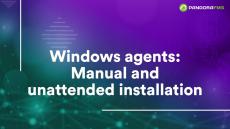|
By Olivia Díaz
Any IT strategist must keep in mind the business goal, so that their technology initiatives are aimed at delivering, rather than services and infrastructure, the added value of reliability and optimal performance that makes them achieve business goals and be more competitive. Read on to understand what KPIs are and how they help us with proper business management.
|
By Pandora FMS team
If Spotify can do its annual wrap-up, so can we! It is true that you will not discover your musical evolution this 2024, but you will be able to check all the advantages that one more year are added to the Pandora FMS portfolio and thereby improve your business operations. 2024 has been a transformational year for Pandora FMS, marked by significant advances and a clear focus on our customers’ global needs.
|
By Pandora FMS team
If Spotify can do its annual wrap-up, so can we! It is true that you will not discover your musical evolution this 2024, but you will be able to check all the advantages that one more year are added to the Pandora FMS portfolio and thereby improve your business operations. 2024 has been a transformational year for Pandora FMS, marked by significant advances and a clear focus on our customers’ global needs.
|
By Rocío Cerón
Whether in personal or professional life, goals always set a direction for where you wish to go, in addition to defining the guidelines with which to reach that desired end. In addition, awareness and motivation are generated about the actions that are carried out, which allows us to focus our energies and efforts.
|
By Olivia Díaz
In the IT infrastructure serving increasingly digitized enterprises, the criticality of network quality of service is more than evident to ensure connectivity to everyone at any time. System and network administrators need to understand which technology enables efficient, reliable, and lowest latency data transmission between IT applications and services.
|
By Olivia Díaz
Subnetting is the process of dividing a network into several smaller, independent subnets. Each subnet is a portion of the core network that follows a specific logic. We know the definition of the use of subnets in local networks that we could use in our company, y, since the benefits of using subnetting are several.
|
By Olivia Díaz
The infrastructure must be “invisible” to the user, but visible to IT strategists to ensure the performance and service levels required by the business, where observability (as part of SRE or site reliability engineering) is essential to understand the internal state of a system based on its external results. For effective observability, there are four key pillars: metrics, events, logs, and traces, which are summarized in the acronym MELT.
|
By Rocío Cerón
In a business world increasingly oriented towards efficiency and mobility, network management becomes a critical factor for success. Cisco Meraki stands as an undisputed leader thanks to its ability to offer a fully cloud-based technology, allowing companies of any size to manage their network devices remotely and centrally.
|
By Olivia Díaz
We recently published the IT Topic “IT System Monitoring: advanced solutions for total visibility and security”, in which we present how advanced solutions for IT system monitoring optimize performance, improve security and reduce alert noise with AI and machine learning. We also mentioned that there are four golden signals that IT systems monitoring should focus on.
|
By Olivia Díaz
Learn the differences between SLA, SLO and SLI and how to implement these metrics to improve the quality of service offered by your company. Also, learn about the challenges and best practices for implementing them, along with some real-world examples.
|
By Pandora FMS
Databases are a critical component of our systems and their malfunction can affect business productivity. Therefore, we must make sure that they are working correctly. PandoraFMS has a plugin that allows the remote monitoring of MySQL databases through a Discovery task, by means of this task we can obtain information about the performance and status of the database, such as the number of connections, the availability of the database, the number of queries that are being made, buffer status and cache status, among other types of information.
|
By Pandora FMS
Proxmox is an open source server virtualization environment. With this plugin, and by using the API, we will be able to extract data about nodes, backups, virtual machines and existing lxc containers, as well as information related to the system storage. In this video we see how the plugin works at a manual execution level in the terminal and how to register and use it in our PandoraFMS console.
|
By Pandora FMS
Network maps are very useful to have a graphical representation of the networks to monitor and their components, supervising at all times the irregularities that may arise, and that may compromise the operation of our services and business productivity. In this video you will learn how to create network maps and how to manage them.
|
By Pandora FMS
Pandora FMS external API is used to integrate third party applications with Pandora FMS and now we will be able to authenticate against it using the Bearen Token. It is a type of identification through HTTP headers that allows that each registered user in our Pandora FMS server can generate its own identifier of unique correspondence to make calls to the same API. In today's video we are going to show you how to generate these identifiers of the users of our server and how to make calls to the API with this identifier.
|
By Pandora FMS
Learn how to create planned stops. Imagine that we are monitoring our resources, and we have to do a maintenance of an equipment that is being monitored, that equipment, or some of its services, will stop being operative and false alerts and events will be generated. To avoid this, there are the planned stops, a PandoraFMS system that allows us to deactivate the agents and modules that we select during a time interval, this way we will avoid receiving false alerts and events.
|
By Pandora FMS
Backup copies are an almost mandatory prevention method in any environment in order to have the most critical elements secured against possible damages or loss of information. For this reason, today we bring you this video where we are going to see how to make security copies of the main elements of Pandora FMS and how to recover them in a very simple way.
|
By Pandora FMS
Are you new to Pandora FMS and don't know how to make your enviroment work? Then check this video and start monitoring like a pro!
|
By Pandora FMS
Software agents are the perfect tool to monitor any type of metric or data from our servers or computers in general. In this video we are going to see how to install this tool in Windows systems, manually and unattended.
|
By Pandora FMS
In Pandora FMS we have several ways to install a satellite server. This time we are going to see how we can install this server automatically with the online installation script, available for Rocky Linux 8.x, AlmaLinux 8.x and RHEL 8.x operating systems.
|
By Pandora FMS
With the launch of the new interface of the 770 version of our console, we also added a series of widgets ready to be used in our Dashboards. In this video we will learn how to create them and how they work.
- January 2025 (2)
- December 2024 (1)
- November 2024 (1)
- October 2024 (1)
- August 2024 (2)
- July 2024 (2)
- June 2024 (1)
- May 2024 (1)
- April 2024 (1)
- March 2024 (5)
- February 2024 (4)
- January 2024 (2)
- December 2023 (6)
- October 2023 (4)
- September 2023 (4)
- August 2023 (7)
- July 2023 (4)
- June 2023 (5)
- May 2023 (7)
- April 2023 (6)
- March 2023 (5)
- February 2023 (4)
- January 2023 (3)
- December 2022 (3)
- November 2022 (7)
- October 2022 (8)
- September 2022 (7)
- August 2022 (6)
- July 2022 (5)
- June 2022 (9)
- May 2022 (7)
- April 2022 (9)
- March 2022 (10)
- February 2022 (9)
- January 2022 (2)
- December 2021 (9)
- November 2021 (11)
- October 2021 (8)
- September 2021 (6)
- August 2021 (6)
- July 2021 (5)
- June 2021 (8)
- May 2021 (9)
- April 2021 (6)
- March 2021 (7)
- February 2021 (9)
- January 2021 (8)
- December 2020 (16)
- November 2020 (16)
- October 2020 (16)
- September 2020 (16)
- August 2020 (15)
- July 2020 (13)
- June 2020 (8)
- May 2020 (8)
- April 2020 (9)
- March 2020 (9)
- February 2020 (5)
- January 2020 (9)
- December 2019 (7)
- November 2019 (3)
- October 2019 (9)
- September 2019 (1)
- August 2019 (5)
- July 2019 (5)
- June 2019 (6)
- May 2019 (4)
- April 2019 (4)
- March 2019 (7)
- February 2019 (10)
- January 2019 (9)
- December 2018 (9)
- November 2018 (6)
- October 2018 (9)
- September 2018 (5)
- August 2018 (4)
- July 2018 (4)
- May 2017 (1)
- April 2017 (2)
- June 2016 (1)
- May 2016 (1)
- March 2016 (2)
- February 2016 (1)
A single monitoring solution to control your business. With just one tool, you can monitor any device, infrastructure, application, service and business process.
Pandora FMS is a monitoring software for IT infrastructure management which includes network equipment, Windows and Unix servers, virtual infrastructure and all different kind of applications. It has a large amount of features, making it a new generation software which discovers all the monitoring issues that an organization may need.
Main features:
- Network monitoring
- WMI monitoring
- Agent monitoring (for all OS)
- Graphical reporting, based on it's own SQL backend
- SLA, and ITIL KPI metrics on reporting
- Status & Performance monitoring
- GIS tracking and viewing
- Inventory management (Local and remote)
- User defined visual console screens and Dashboards WYSIWYG
- Very high capacity (Thousands of devices)
- Multiuser, several levels of ACL management.
Pandora FMS exists as a full-powered Community edition with forum-based community support as well as an Enterprise edition which includes professional support and access to new versions.

















